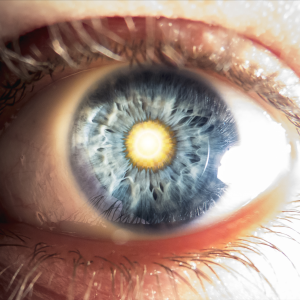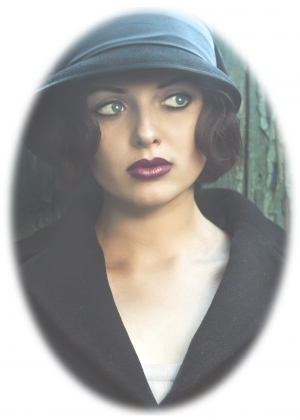The 1980’s classic, Blade Runner, was years ahead of it’s time with special effects.
One of the most notable parts of this film were the glowing eyes of the Replicants–but how did they do it?
You can recreate this effect right at home, no CGI required.
“The human eye is like a two way mirror; the eye doesn’t only see a lot, the eye gives away a lot”

If you haven’t seen Blade Runner, you’re missing out on bioengineered androids, intense action shots, and a young Harrison Ford. That alone should make you want to watch the movie, but if it doesn’t, give it a watch for the extremely unique special effects.
The bioengineered androids–called Replicants–both look and act like humans. They have memories and feelings, just like we do. As humans, one of the most expressive features on our faces are our eyes. This meant that the Replicants eye’s needed to have something a little less than human to make them stand out.

When watching the film, viewers will notice that some characters have glowing pupils. This wasn’t a camera flaw or lighting gone wrong. Director Ridley Scott made this choice to help his audience recognize who the Replicants were.
Critics have pointed out over the years that there was inconsistency with the eyes glowing–sometimes they did, sometimes they didn’t.
What critics failed to understand is that the glowing eyes weren’t there for the characters or actors, but rather for the audience. The Replicants eyes didn’t actually glow in the world of Blade Runner. It was simply a stylistic choice to help the audience follow the narrative.
How Does It Work?
Have you ever seen a photo where someone’s eyes were glowing and had a “red” tint? This is essentially the same effect in done in Blade Runner, except it’s done intentionally so there’s more control.
When a light (or the flash of a camera) is in someone’s eyes at the correct angle, it affects the pupil. The pupil doesn’t have enough time to constrict the amount of light entering the eye. A burst of light reaches the retinas and reflects back–this is what’s captured on film.
The redness that is captured is actually from blood vessels in the back of your eyes!
Step 1
- First, set your camera up on your tripod making sure that it is placed where you will be recording your scene.
- If you do not have a tripod, set your camera on a flat surface, like a table
Step 2
- Next, you will put a shroud over your set up. The shroud needs to go over the camera and the top of the mirror to block any light that may leak in.
- If you don’t have a shroud then you can use a folder or a dark colored t-shirt–really anything that will block light.
Step 3
- Then, position your mirror/glass at a 45 degree angle in accordance with your camera.
- The mirror can be above, below, or beside your camera depending on the placement/height of your talent.
Step 4
- Now, it’s time to position your light source. From where your talent will be standing, they should be able to see the reflection of the light directly in front of the camera lens.
- Light source reflection, center of lens, and clients line of sight all need to be in one line.
- The direct light source should not be in line of sight of the talent. You can put a block on the talent side of the light source if needed.
Additional Notes
So, If you haven’t seen Ridley Scott’s 1982 classic film, Blade Runner, you’ve at least heard of it. With the sequel, Blade Runner 2049 coming out in 2017, movie buffs everywhere were reminded just how iconic the original was.
Today, I’m going to teach you about a really cool, yet really simple special effect that you can recreate right at home. We will be going over why design choices were made, as well as how they were done to create the glowing Replicant eyes in the movie.
Hi, I’m Sydney with Two Way Mirrors. Every week we bring you new DIY hacks based on our expertise in the optical mirror industry.
Let’s get to it!
For those of you who haven’t seen Blade Runner, you’re probably thinking “what is this girl talking about”. Let’s give the movie newbies a quick rundown.
Picture this: a dystopian society set in 2019 Los Angeles. Well, what they thought 2019 would look like back in the 80’s.
Bio-engineered humans, called replicants, are being created to work at space colonies. Some of the Replicants escape back to earth, and Rick Deckard is sent to earth to go find them.
That was a super brief overview, but you’ll have to experience this cinematic masterpiece yourself to get the full story.
In the movie, Replicants look just like humans with one simple thing that sets them apart–their eyes. When watching the film, the audience will notice that the Replicants have glowing pupils.
What was the reasoning behind this?
This question has been up for debate for quite some time. In the film, there is a test done with a device called the Voight Kamff machine that helps to decipher who’s a replicant and who’s a human.
If the Replicants’ eyes glow anyways, wouldn’t that be a dead giveaway? Why would they need the Voight Kamff machine?
The answer is simple: the glowing eyes are simply there for the audience.
In the words of Ridley Scott, “. . .the eye is really the most important organ in the human body. It’s like a two way mirror; the eye doesn’t only see a lot, the eye gives away a lot. A glowing human retina seemed one way of stating that”.
It’s metaphoric in a sense, while also giving the audience a clue to who is a Replicant without waiting for Voight Kamff scenes.
Humans usually have a little glint in their eye. A small reflection of light that shows that we are, in fact, alive. Taking that small glint away from the Replicants sets them apart from the rest of the cast.
Now we know a little about the movie, as well as reasoning for stylistic choices, so next up is the fun part. Let’s move on to how to create your very own Replicant appearance at home!
While many people might believe that the glowing eyes were added in AFTER filming, that is not the case. The coolest part about the glowing eye effect in my opinion is that it was done live on set!
This can be done with minimal supplies that the average person has easy access to. You will need: a camera, a two way mirror, a light source, and something to block out light such as a shroud.
For our recreation, we’re using a Nikon 1DX Mark 3, one of our presidential teleprompters with a black shroud attached, a tripod, and an iPad for a light source.
You’ll start by getting your camera set up. Your camera lens needs to be eye level with the talent for this to work. For this reason, a tripod is ideal, but if you don’t have a tripod then sitting the camera on another tall flat surface will work just as well.
After you get the camera focused and ready, you’re going to get your two way mirror set up. Our presidential teleprompter comes on a tripod with a two way mirror already attached.
The key to this part is getting the two way mirror angled at about 45 degrees in accordance with the camera lens. This is going to ensure that when the light is reflected
